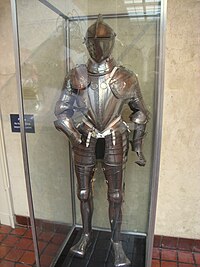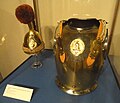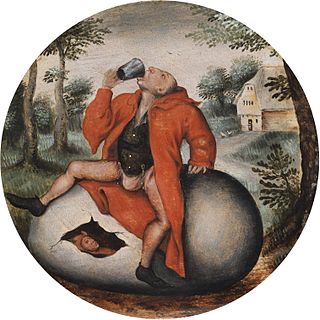
A codpiece is a covering flap or pouch that attaches to the front of the crotch of men's trousers, enclosing the genital area. It may be held closed by string ties, buttons, folds, or other methods. It was an important fashion item of European clothing during the fifteenth and sixteenth centuries. In the modern era, clothing devices with similar functions as codpieces are worn in some styles of underwear, in the leather subculture, and in performance costumes, such as for rock music and metal musicians. A similar device with rigid construction, an athletic cup, is used as protective underwear for male athletes.

Jousting is a martial game or hastilude between two horsemen wielding lances with blunted tips, often as part of a tournament. The primary aim was to replicate a clash of heavy cavalry, with each participant trying hard to strike the opponent while riding towards him at high speed, breaking the lance on the opponent's shield or jousting armour if possible, or unhorsing him. The joust became an iconic characteristic of the knight in Romantic medievalism. The participants experience close to three and a quarter times their body weight in G-forces when the lances collide with their armour.

Plate armour is a historical type of personal body armour made from bronze, iron, or steel plates, culminating in the iconic suit of armour entirely encasing the wearer. While there are early predecessors such as the Roman-era lorica segmentata, full plate armour developed in Europe during the Late Middle Ages, especially in the context of the Hundred Years' War, from the coat of plates worn over mail suits during the 14th century.

Combat reenactment is a side of historical reenactment which aims to depict historical forms of combat. This may refer to either single combat, melees involving small groups, or nearly full-scale battles with hundreds of participants.
John Woodman Higgins was an American businessman and owner of the Higgins Armory Museum.
The Kabutowari, also known as hachiwari, was a type of knife-shaped weapon, resembling a jitte in many respects. This weapon was carried as a side-arm by the samurai class of feudal Japan.
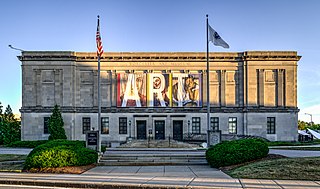
The Worcester Art Museum, also known by its acronym WAM, houses over 38,000 works of art dating from antiquity to the present day and representing cultures from all over the world. WAM opened in 1898 in Worcester, Massachusetts, and ranks among the more important art museums of its kind in the nation. Its holdings include some of the finest Roman mosaics in the United States, outstanding European and American art, and a major collection of Japanese prints. Since acquiring the John Woodman Higgins Armory Collection in 2013, WAM is also home to the second largest collection of arms and armor in the Americas. In many areas, it was at the forefront in the US, notably as it collected architecture, acquired paintings by Monet (1910) and Gauguin (1921), presented photography as an art form (1904) The Worcester Art Museum also has a conservation lab and year-round studio art program for adults and youth.
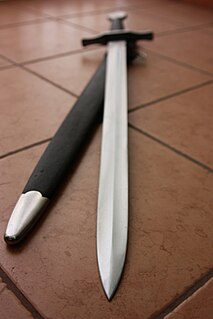
Hanwei is a Chinese company manufacturing replica swords and other types of medieval arms and armor. The company was founded in 1990 by Chen Chao-Po.

Bashford Dean was an American zoologist, specializing in ichthyology, and at the same time an expert in medieval and modern armor. He is the only person to have held concurrent positions at the American Museum of Natural History and the Metropolitan Museum of Art, where he was Honorary Curator of Arms and Armor; the Metropolitan Museum purchased his collection of arms and armor after his death.

The Royal Armouries Museum in Leeds, West Yorkshire, England, is a national museum which displays the National Collection of Arms and Armour. It is part of the Royal Armouries family of museums, the other sites being the Tower of London, its traditional home, Fort Nelson, Hampshire, for the display of its National Collection of Artillery, and permanent galleries within the Frazier History Museum in Louisville, Kentucky, USA. The Royal Armouries is a non-departmental public body sponsored by the Department for Culture, Media and Sport.
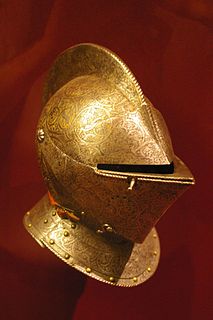
The close helmet or close helm is a type of military helmet that was worn by knights and other men-at-arms in the Late Medieval and Renaissance eras. It was also used by some heavily armoured, pistol-armed, cuirassiers into the mid 17th century. It is a fully enclosing helmet with a pivoting visor and integral bevor.

Greenwich armour is the plate armour in a distinctively English style produced by the Royal Almain Armoury founded by Henry VIII in 1511 in Greenwich near London, which continued until the English Civil War. The armoury was formed by imported master armourers hired by Henry VIII, initially including some from Italy and Flanders, as well as the Germans who dominated during most of the 16th century. The most notable head armourer of the Greenwich workshop was Jacob Halder, who was master workman of the armoury from 1576 to 1607. This was the peak period of the armoury's production and it coincided with the elaborately gilded and sometimes coloured decorated styles of late Tudor England.
The Brocas helm is a jousting helm on display at the Rotunda as part of the Tower of London armoury collection. It was commissioned by an English knight from an Italian armourer.

The Royal Armoury of Madrid or Real Armería de Madrid, between many other things, the collection contains the personal arms of the Kings of Spain, and also houses military weapons, armours and diplomatic works of art like mixed tapestries, paintings and other works of art and trophies. Among the most notable parts of the collection features armor and full tools that Charles V, Holy Roman Emperor and Philip II used. It is considered, along with the Imperial Armory of Vienna, one of the best in the world., and even it is often described as "the best collection of its kind in the world".

The Parade Armour of Henry II of France, now in Metropolitan Museum of Art, New York, is believed to date from c 1553–55 and its decoration is attributed to the French goldsmith and engraver Étienne Delaune. Designed for use in pageantry, the armour was fashioned of gold, silver and steel and with leather and red velvet trimmings. It was created for Henry II of France as ceremonial wear; the figures embossed on the breastplate and back are intended to reflect his military achievements.

The Armor of Emperor Ferdinand I is a suit of plate armor created by the Nuremberg armorer Kunz Lochner in 1549 for the future Ferdinand I, Holy Roman Emperor. One of several suits of armor made for the Emperor Ferdinand during the wars of Reformation and conflict with the Ottomans, the etched but functional armor is thought by scholars to symbolize and document the role of the Habsburg Catholic monarchs as warriors on Europe's literal and ideological battlefields.
Ian Donald Dietrich Eaves,, is a British researcher and consultant on arms and armour. He served as the Keeper of Armour at the Royal Armouries for eighteen years, from 1978 to 1996. Also starting in 1978, and continuing until 1983, he served as the editor of the Journal of the Arms & Armour Society; he was appointed the society's president in 1995, and currently serves as a vice-president emeritus. He has written and translated several articles for journals, including the society's.

A Turban helmet is a variety of Turkish helmet specifically known for its bulbous shape and fluting that imitates the folds of a turban. Turban helmets originated in Ottoman Turkey, primarily used by warriors and some external attics.

The Higgins Armory Building is a historic structure, held to be the first building constructed solely out of steel and glass. It was built on the premises of the Worcester Pressed Steel Company owned by John Woodman Higgins to house his museum-worthy collection of steel artifacts, mostly European weapons and armor but also early American steel constructs. The L-shaped building appears to be a massive city-block sized structure, but in reality it wraps around the former factory, to which it was connected via catwalks. The building was often used to impress potential clients, as well as becoming a locally known museum and cultural venue open to the public.
